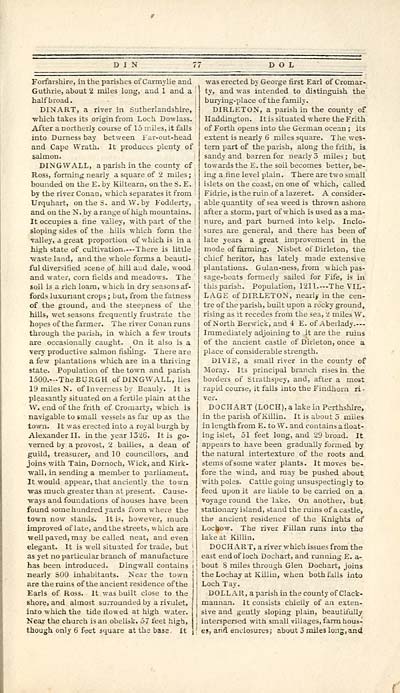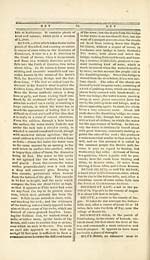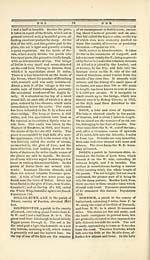Gazetteer of Scotland
(79) Page 77
Download files
Complete book:
Individual page:
Thumbnail gallery: Grid view | List view

DIN
D O L
Forfarshire, in the parishes of Carmylie and
Guthrie, about 2 miles long, and 1 and a :
half broad.
DINART, a river in Sutherlandshire,
which takes its origin from Loch Dovlass.
After a northerly course of 15 miles, it falls
into Durness bay between Far-out-head
and Cape Wrath. It produces plenty of
salmon.
DINGWALL, a parish in the county of
Ross, forming nearly a square of 2 miles ;
bounded on the E. by Kiltearn, on the S. E.
by the river Conan, which separates it from
Urquhart, on the S. and W. by Fodderty,
and on the N. by a range of high mountains. !
It occupies a fine valley, with part of the
sloping sides of the hills which form the
valley, a great proportion of which is in a
high state of cultivation.— There is little
•waste land, and the whole forms a beauti-
ful diversified scene of hill aad dale, wood
and water, corn fields and meadows. The
soil is a rich loam, which in dry seasons af-
fords luxuriant crops ; but, from the fatness
of the ground, and the steepness of the
hills, wet seasons frequently frustrate the
hopes of the farmer. The river Conan runs
through the parish, in which a few trouts
are occasionally caught. On it also is a
very productive salmon fishing. There are
a few plantations which are in a thriving
state. Population of the town and parish
1500.— TheBURGH of DINGWALL, lies
19 miles N. of Inverness by Beauly. It is
pleasantly situated on a fertile plain at the
W. end of the frith of Cromarty, which is
navigable to small vessels as far up as the
town. It was erected into a royal burgh by
Alexander II. in the year 1326. It is go-
verned by a provost, 2 bailies, a dean of
guild, treasurer, and 10 councillors, and
joins with Tain, Dornoch, Wick, and Kirk-
wall, in sending a member to parliament.
It would appear, that anciently the town
was much greater than at present. Cause-
ways and foundations of houses have been
found some hundred yards from where the |
town now stands. It is, however, much I
improved of late, and the streets, which are I
well paved, may be called neat, and even
elegant. It is well situated for trade, but '
as yet no particular branch of manufacture
has been introduced. Dingwall contains 1 1
nearly S00 inhabitants. Near the town < <
are the ruins of the ancient residence of the | j
Earls of Ross. It was built close to the
shore, and almost surrounded by a rivulet,
into which the tide flowed at high water.
Near the church is an obelisk, 57 feet high,
though only 6 feet square at the base. It
was erected by George first Earl of Cromar-
ty, and was intended to distinguish the
burying-place of the family.
DIRLETON, a parish in the county of
Haddington. It is situated where the Frith
of Forth opens into the German ocean ; its
extent is nearly 6 miles square. The wes-
tern part of the parish, along the frith, is
sandy and barren for nearly 3 miles; but
towards the E. the soil becomes better, be-
ing a fine level plain. There are two small
islets on the coast, on one of which, called
Fidrie, is the ruin of a lazeret. A consider-
able quantity of sea weed is thrown ashore
after a storm, part of which is used as a ma-
nure, and part burned into kelp. Inclo-
sures are general, and there has been of
late years a great improvement in the
mode of farming. Nisbet of Dirleton, the
chief heritor, has lately made extensive
plantations. Gulan-ness, from which pas-
sage-boats formerly sailed for Fife, is in
this parish. Population, 1211. — The TIL-
LAGE ofDIRXETON, nearly in the cen-
tre of the parish, built upon a rocky ground,
rising as it recedes from the sea, -l miles W.
of North Berwick, and 4 E. of Aberlady.—
Immediately adjoining to it are the ruins
of the ancient castle of Dirleton, once a
place of considerable strength.
DIVIE, a small river in the county of
Moray. Its principal branch rises in the
borders of Strathspey, and, after a most
rapid course, it falls into the Findhorn ri .
ver.
DOCHART (LOCH), a lake in Perthshire,
in the parish of Killin. It is about 5 miles
in length from E. to W. and contains a float-
ing islet, 51 feet long, and 29 broad. It
appears to have been gradually formed by
the natural intertexture of the roots and
stems of some water plants. It moves be-
fore the wind, and may be pushed about
with poles. Cattle going unsuspectingly to
feed upon it are liable to be carried on a
voyage round the lake. On another, but
stationary island, stand the ruins of a castle,
the ancient residence of the Knights of
Lochow. The river Fillan runs into the
lake at Killin.
DOCHART, a river which issues from the
east end of loch Dochart, and running E. a-
bout 8 miles through Glen Dochart, joins
the Lochay at Killin, when both falls into
Loch Tay.
DOLLAR, a parish in the county of Clack-
mannan. It consists chiefly of an exten-
sive and gently sloping plain, beautifully
interspersed with small villages, farm hous-
es, and enclosures; about 5 miles long, and
D O L
Forfarshire, in the parishes of Carmylie and
Guthrie, about 2 miles long, and 1 and a :
half broad.
DINART, a river in Sutherlandshire,
which takes its origin from Loch Dovlass.
After a northerly course of 15 miles, it falls
into Durness bay between Far-out-head
and Cape Wrath. It produces plenty of
salmon.
DINGWALL, a parish in the county of
Ross, forming nearly a square of 2 miles ;
bounded on the E. by Kiltearn, on the S. E.
by the river Conan, which separates it from
Urquhart, on the S. and W. by Fodderty,
and on the N. by a range of high mountains. !
It occupies a fine valley, with part of the
sloping sides of the hills which form the
valley, a great proportion of which is in a
high state of cultivation.— There is little
•waste land, and the whole forms a beauti-
ful diversified scene of hill aad dale, wood
and water, corn fields and meadows. The
soil is a rich loam, which in dry seasons af-
fords luxuriant crops ; but, from the fatness
of the ground, and the steepness of the
hills, wet seasons frequently frustrate the
hopes of the farmer. The river Conan runs
through the parish, in which a few trouts
are occasionally caught. On it also is a
very productive salmon fishing. There are
a few plantations which are in a thriving
state. Population of the town and parish
1500.— TheBURGH of DINGWALL, lies
19 miles N. of Inverness by Beauly. It is
pleasantly situated on a fertile plain at the
W. end of the frith of Cromarty, which is
navigable to small vessels as far up as the
town. It was erected into a royal burgh by
Alexander II. in the year 1326. It is go-
verned by a provost, 2 bailies, a dean of
guild, treasurer, and 10 councillors, and
joins with Tain, Dornoch, Wick, and Kirk-
wall, in sending a member to parliament.
It would appear, that anciently the town
was much greater than at present. Cause-
ways and foundations of houses have been
found some hundred yards from where the |
town now stands. It is, however, much I
improved of late, and the streets, which are I
well paved, may be called neat, and even
elegant. It is well situated for trade, but '
as yet no particular branch of manufacture
has been introduced. Dingwall contains 1 1
nearly S00 inhabitants. Near the town < <
are the ruins of the ancient residence of the | j
Earls of Ross. It was built close to the
shore, and almost surrounded by a rivulet,
into which the tide flowed at high water.
Near the church is an obelisk, 57 feet high,
though only 6 feet square at the base. It
was erected by George first Earl of Cromar-
ty, and was intended to distinguish the
burying-place of the family.
DIRLETON, a parish in the county of
Haddington. It is situated where the Frith
of Forth opens into the German ocean ; its
extent is nearly 6 miles square. The wes-
tern part of the parish, along the frith, is
sandy and barren for nearly 3 miles; but
towards the E. the soil becomes better, be-
ing a fine level plain. There are two small
islets on the coast, on one of which, called
Fidrie, is the ruin of a lazeret. A consider-
able quantity of sea weed is thrown ashore
after a storm, part of which is used as a ma-
nure, and part burned into kelp. Inclo-
sures are general, and there has been of
late years a great improvement in the
mode of farming. Nisbet of Dirleton, the
chief heritor, has lately made extensive
plantations. Gulan-ness, from which pas-
sage-boats formerly sailed for Fife, is in
this parish. Population, 1211. — The TIL-
LAGE ofDIRXETON, nearly in the cen-
tre of the parish, built upon a rocky ground,
rising as it recedes from the sea, -l miles W.
of North Berwick, and 4 E. of Aberlady.—
Immediately adjoining to it are the ruins
of the ancient castle of Dirleton, once a
place of considerable strength.
DIVIE, a small river in the county of
Moray. Its principal branch rises in the
borders of Strathspey, and, after a most
rapid course, it falls into the Findhorn ri .
ver.
DOCHART (LOCH), a lake in Perthshire,
in the parish of Killin. It is about 5 miles
in length from E. to W. and contains a float-
ing islet, 51 feet long, and 29 broad. It
appears to have been gradually formed by
the natural intertexture of the roots and
stems of some water plants. It moves be-
fore the wind, and may be pushed about
with poles. Cattle going unsuspectingly to
feed upon it are liable to be carried on a
voyage round the lake. On another, but
stationary island, stand the ruins of a castle,
the ancient residence of the Knights of
Lochow. The river Fillan runs into the
lake at Killin.
DOCHART, a river which issues from the
east end of loch Dochart, and running E. a-
bout 8 miles through Glen Dochart, joins
the Lochay at Killin, when both falls into
Loch Tay.
DOLLAR, a parish in the county of Clack-
mannan. It consists chiefly of an exten-
sive and gently sloping plain, beautifully
interspersed with small villages, farm hous-
es, and enclosures; about 5 miles long, and
Set display mode to: Large image | Transcription
Images and transcriptions on this page, including medium image downloads, may be used under the Creative Commons Attribution 4.0 International Licence unless otherwise stated. ![]()
| Gazetteers of Scotland, 1803-1901 > Gazetteer of Scotland > (79) Page 77 |
|---|
| Permanent URL | https://digital.nls.uk/97422642 |
|---|

